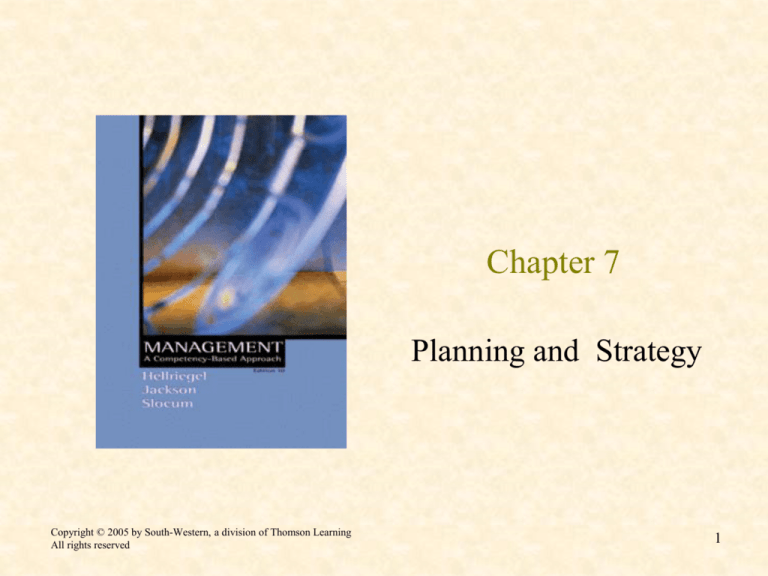
Chapter 7
Planning and Strategy
Copyright © 2005 by South-Western, a division of Thomson Learning
All rights reserved
1
Learning Objectives
• Explain the importance of the planning
function.
• Describe the core components of strategic and
tactical planning.
• Discuss the effects of degree of diversification
on planning.
• Describe the three basic levels of strategy and
planning.
Copyright © 2005 by South-Western, a division of Thomson Learning
All rights reserved
2
Learning Objectives (cont.)
• State the eight primary tasks of the planning
process.
• Explain the generic competitive strategies
model.
Copyright © 2005 by South-Western, a division of Thomson Learning
All rights reserved
3
Planning
A process whereby managers select goals,
choose actions (strategies) to attain those
goals, allocate responsibility for implementing
actions to specific individuals or units,
measure the success of actions by comparing
actual results against the goals, and revise
plans accordingly. So, the main steps are as:
Choose Goals—Identify Actions—Allocate
responsibility—Review Performance– Make
adjustments.
Copyright © 2005 by South-Western, a division of Thomson Learning
All rights reserved
4
Types of Planning
•
Strategic Planning is the process of
1) diagnosing the organization’s external and internal
environments,
2) deciding on a vision and mission,
3) developing overall goals,
4) creating and selecting general strategies to be pursued,
and
5) allocating resources to achieve the organization’s goals.
Contingency planning-it is formulated to address
specific possible future events that might have a
significant impact on organization. (i) Crisis Management,
(ii) Scenario plans
Copyright © 2005 by South-Western, a division of Thomson Learning
All rights reserved
5
Strategic Planning
• The four main aspects of strategic planning
that managers can directly influence include:
–
–
–
–
Vision and Mission
Goals
Strategies
Resource Allocation
Copyright © 2005 by South-Western, a division of Thomson Learning
All rights reserved
6
Types of Planning (cont.)
Tactical planning involves making concrete
decisions regarding what to do, who will do
it, and how to do it—with a normal time
horizon of a year or less.
Tactical plans outline managers must adopt
over the short to medium term to cope with a
specific opportunity or threat that has
emerged.
Copyright © 2005 by South-Western, a division of Thomson Learning
All rights reserved
7
Degree of Diversification and Planning
• Diversification refers to the variety of goods and/or
services produced by an organization and the number
of different markets it serves.
• Questions that can identify potential risks and
opportunities of diversification include:
– What can we do better than other firms if we enter a new
market?
– What strategic resources—human, financial, and others—do
we need to succeed in the new market?
– Will we simply be a player in the new market or will we
emerge a winner?
– What can we learn by diversifying, and are we sufficiently
organized to learn it?
Copyright © 2005 by South-Western, a division of Thomson Learning
All rights reserved
8
Degree of Diversification and Planning
(adapted from Figure 7.1)
High
Complexity of
Strategic Planning
General
Electric
Johnson &
Johnson
CEMEX
Google
Low
Low
Singlebusiness
firm
Dominantbusiness
firm
Relatedbusiness
firm
Unrelatedbusiness
firm
High
Degree of Diversification
Copyright © 2005 by South-Western, a division of Thomson Learning
All rights reserved
9
Strategic Levels and Planning
• Corporate-level strategy focuses on the types of
businesses the firm wants to be in, ways to acquire or
divest businesses, allocation of resources among the
businesses, and ways to develop learning and synergy
among those businesses.
– Strategic business unit (SBU)
– Growth Strategies
Forward integration
Backward integration
Horizontal integration
Concentric diversification
Conglomerate diversification
Copyright © 2005 by South-Western, a division of Thomson Learning
All rights reserved
10
Strategic Levels and Planning Contd.
Strategic business unit (SBU):- a strategic business unit (SBU)
is a profit center within a larger corporation, or it may be a
business unto itself, which focuses on product offering and
market segment.
Forward integration-Company expand its operation forward
into an industry that uses, distributes or sell the the company’s
product.
Backward integration-Company expand its operation
backward into an industry that produces input for the
company’s product.
Horizontal integration-The process of acquiring or merging
with industry competitors in an effort to achieve competitive
advantage.
Concentric
diversification-A
company
acquires
or develops new products or services closely related to
its core business
Copyright © 2005 by South-Western, a division of Thomson Learning
All rights reserved
11
Strategic Levels and Planning Contd.
Conglomerate diversification- A company enters through
acquisition or merger an entirely different market that has
little or no synergy with its core business.
Copyright © 2005 by South-Western, a division of Thomson Learning
All rights reserved
12
Strategic Levels and Planning (cont.)
• Business-level strategy refers to the resources
allocated and actions taken to achieve desired
goals in serving a specific market with a highly
interrelated set of goods and/or services.
• Three basic questions at the business level are:
1. Who will we be served?
2. What customer needs will be satisfied?
3. How will customer's need be satisfied?
Copyright © 2005 by South-Western, a division of Thomson Learning
All rights reserved
13
Strategic Levels and Planning (cont.)
• Functional-level strategy refers to the actions
and resource commitments established for
operations, marketing, human resources,
finance, legal services, accounting, and the
organization’s other functional areas.
– Operations strategies
– Marketing strategies
– Finance strategies
Copyright © 2005 by South-Western, a division of Thomson Learning
All rights reserved
14
General Electric’s Strategy and Planning Levels
(adapted from Figure 7.2)
Corporate
Level
Four senior executive officers, 8 senior corporate officers,
And 33 corporate staff officers
Focus: Assessing new businesses, allocating resources to businesslevel companies, coordinating businesses, resolving legal
issues, assessing key executives, and other activities
Business
Level *
Functional
Level
GE
Consumer
Finance
GE
Plastics
GE
Transportation
Systems
Plus 10 other
primary
business units
Marketing
Marketing
Marketing
Human
Resources
Human
Resources
Human
Resources
Finance/
Accounting
Finance/
Accounting
Finance/
Accounting
Functional
Units
in each
line of
Business
Other
Other
Other
* Each of the 13 primary units has its own business functions
Copyright © 2005 by South-Western, a division of Thomson Learning
All rights reserved
15
The Planning Process
(adapted from Figure 7.3)
Task 1:
Develop vision,
mission
and Goals
Task 2:
Diagnose
opportunities
and threats
Task 4:
Develop
strategies
Task 5:
Prepare strategic
plan
Task 7:
Control and
diagnose results
Task 6:
Prepare tactical
plans
Task 3:
Diagnose strengths
and weakness
Task 8:
Continue
planning
Copyright © 2005 by South-Western, a division of Thomson Learning
All rights reserved
16
Generic Competitive Strategies Model
(adapted from Figure 7.4)
Strategic Target
Broad
Differentiation
Strategy
Cost Leadership
Strategy
Focused
Differentiation
Strategy
Focused
Cost Leadership
Strategy
Narrow
Uniqueness
Low Cost (price)
Source of Advantage
Copyright © 2005 by South-Western, a division of Thomson Learning
All rights reserved
17










